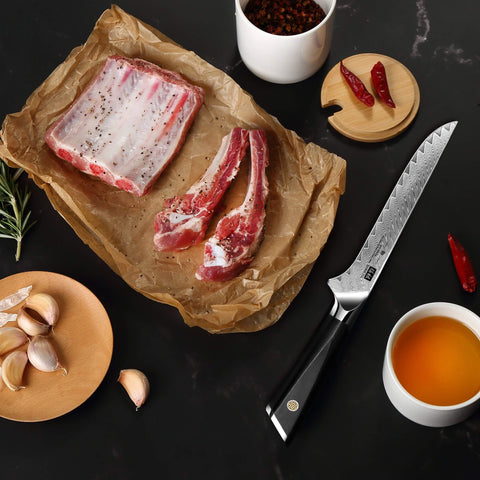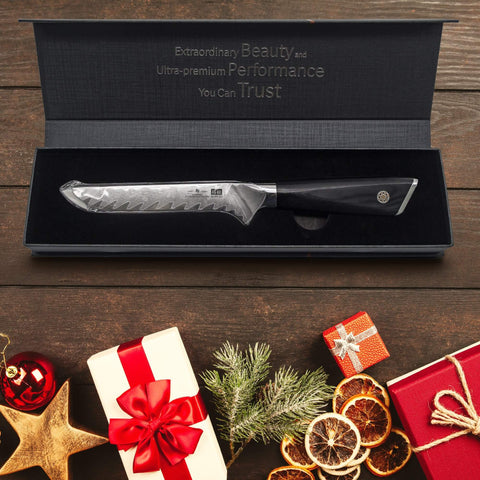Knives are important tools to help you with a variety of tasks around the kitchen. Each task requires a specific kind of knife, such as removing the bones and skin of the meat. This kind of knife is known as a boning knife.
What is a Boning Knife?

A boning knife comes with a thin, flexible, and most importantly, sharp blade to help facilitate separating the bones of meat. Its curved blade is designed to allow you to remove the meat from the joints and bones with ease, with little to no wastage. Moreover, it enables you to cut precise and thin slices.
The Blade of a Boning Knife
Often, you will find that the most delicious part of the meat is closest to the bones. Therefore, you need a good-quality boning knife with a suitable blade to make sure that you can remove this flavorful part.
A suitable boning knife that works for both home and professional use is the classic kind. It comes with a flexible and soft blade and can easily be used to navigate the outline of the bone of the meat. However, if you need a boning knife for a particular kind of meat you are handling, there are several blades for you to choose from.
· Flexible Blade
This type of blade can blend in to carry out the most intricate jobs. It enables you to cut around complex shapes and lighter corners.
· Stiff Blade
Thicker and tougher meat requires a more robust blade to ensure that you do not go off course while separating the beat. Stiff blades are therefore used to make wide cuts.
· Curved Blade
The curve of a boning knife facilitates the removal of bones in one swipe and helps make clean, long strokes through the flesh. The shape also makes it easier to carry out delicate jobs effectively and maneuver easily in small spaces.
· Straight Blade
A straight blade helps in removing big chunks of meat, like beef. It is known for helping with fine sculpting and slicing, as well as high-speed removal.
· Narrow Blade
Sometimes, narrow blades are needed to cut around smaller edges and angles. These travel through the skin with little to no resistance, ensuring no harm to the meat.
· Broad Blade
Broad blades make for sturdy and wide knives, which are important for making thick sections of the meat you are cutting.
· Finger Guard
This is a part of the knife that is located at the rear end of the blade. As suggested by its name, the primary function of a finger guard is to provide your fingers with protection when the handle is in your hand. Therefore, the bigger the size of the finger guard, the lesser the chances are of you cutting yourself with the knife.
The Pros and Cons of a Boning Knife
Overall, a boning knife makes for a good investment and can be used to accomplish several tasks.
- A boning knife comes with a rigid blade, which helps maintain its sharpness for a relatively long time.
- It helps you make smooth cuts, even if you are handling a complex joint of beef.
- It is the reason that you can enjoy the best meat.
- Makes sure that the meat removed is presentable and preserved.
On the other hand, there are a couple of downsides to a boning knife.
- If you use a flexible boning knife to cut a thicker piece of meat, you could end up damaging your knife or injure yourself.
- Using a bigger boning knife for intricate jobs puts you at risk of losing control.
The Differences Between a Fillet Knife and a Boning Knife
While both knives are used to separate skin and bones from meat and fish, they have considerable differences.
· Difference in Purpose
Where a boning knife can be used to separate the skins and bones of poultry, meat, and fish, a fillet knife is better suited to help contend with the tender meat of a fish. consequently, it is smaller in size and more flexible.
· The Difference in Blade Length and Weight
Each knife is available in different lengths. Usually, you will find both to lie somewhere in the 5-to-8-inch range. While they have a similar size, fillet knives are often lighter, as intended by their construction and design. Their blade also tends to be thinner.
· The Difference in Blade Maneuverability
Since fillet knives have been designed to ensure greater flexibility, you can make precise cuts from them. On the other hand, boning knives are known for their rigidity and are mostly used to cut through the connective tissue that separates the meat from the bones.
· The Difference in Blade Design
The design of boning knives cuts that they are straight to the tip of the blade. This is what allows you to pierce through the meat easily. Fillet knives, however, have an upward curve and, therefore, a curved tip. They have been constructed to make it easier for you to make steady and long cuts.
Do You Need a Boning Knife?
Buying a boning knife is a worthwhile investment, especially in the long run, if you usually work with considerably larger pieces of meat. It is important for butchering meat and effective since using an ordinary chefs' knife can only produce sub-par results at best.
When and Why Should You Get One?
Here are several instances when you will want to get yourself a sturdy and quality boning knife.
- Planning on frequently filleting fish or deboning meat and poultry.
- Looking to yield the most flavorful meat that you can find.
- Seeking to make straighter and smoother cuts, thereby making your dishes look presentable.
- Hoping to trim larger pieces of meat into smaller ones.
- When the rest of your ordinary knives start to get damaged or blunt because they are not designed to help in removing bones from meat.
When Do I Not Need One?
There are also times when purchasing a boning knife will prove to be futile. This usually happens in the following cases.
- You want to cut through harder types of cartilage and bones while cutting up animal carcasses.
- You have various other knives that can easily get the job done.
- You do not have to cut up meat regularly.
How to Select a Great Boning Knife
If you already have different knives in your kitchen for various tasks, then kudos to you! However, there is no better knife out there to cut any meat than a boning knife. When picking out one for yourself, here are things that you need to consider.
· Design of the Blade
Where some blades may be curved, some are straight. This design makes all the difference in the world and determines whether you spend 5 minutes removing the bone or twenty. A curved blade enables you to remove the bones with a single pass, whereas a straight blade separates more intricate pieces of meat.
· Handles of the Knife
The handle of a knife is where you put all your pressure. You are free to choose from various handles available, ranging from hard plastic to wood, based on looks and preference. If you are going for synthetic materials, for example, Polypropylene, you will receive a handle with multiple coatings to enhance your grip.
· The Material of the Blade
Stainless steel is primarily used to make blades. Whenever you go out to buy yourself any knife, you will see different forms of this kind of steel, ranging from high carbon to cold steel to tempered. All of these materials will help you get the work done.
High carbon blades are lightweight; durability is the most important feature in cold steel blades. However, any blade type that you pick out can provide you with enough sharpness and durability to debone successfully.
· Size of the Blade
On average, the size of the blade of a boning knife will be somewhere between 5 to 6.5 inches. The smaller the size of the blade, the greater the flexibility that you can expect. Even though one size cannot be used to make all kinds of cuts, you will require a small blade to remove bone from delicate areas.
On the other hand, a larger blade is used to make bigger and broader cuts.
The Usage and Use of a Boning Knife
How to Hold a Boning Knife
The ergonomic shape of a boning knife may take some getting used to. Its curved stainless-steel blade and flexible blade design ensure that it stands out from all other kitchen knives. However, you can easily learn how to use a boning knife, much like how to use the rest of your kitchen tools.
The first thing that you need to do is to hold the knife with your dominant hand. Next, wrap your thumb, middle finger, as well as ring finger around the handle. These three fingers provide you with a good grip throughout the deboning process. Once this is done, take your index finger to the top of the blade and ensure that it is firmly in place. Doing so will help stabilize the movements as you navigate the bones and skin.
Your other hand is to be used to steady the meat throughout the cutting process on the surface you are using. Make sure that your fingers are curled at all times to prevent any accidents or injury to your person.
The Uses of Boning Knife
Here are a handful of uses of a boning knife and how it makes your work easier in the kitchen.
1. Removing Bones
During the process of removing bones, you will first want to ensure that you have a cutting board with you that provides you with enough working space to complete the task.
Take the piece of meat and place it flatly right at the center of the board. Next, locate where the meat ends, and the bone starts, and make an outline of the chosen bone with the tip of your boning knife. With a swift saw motion, use the rest of the blade to detach the meat effectively and easily.
2. Removing Skin from the Meat
As stated, the shape and flexibility of the blade of the boning knife aid in maneuvering in difficult places of the meat.The slender tip is especially instrumental in breaking away the cartilage in the joints. Moreover, you can easily remove the breast from the carcass and break away the high and drumstick from the backbone without taking out any splinters.
All you need to do is make a small cut between the flesh and the skin with the tip of the boning knife. Then, make sure to have a firm grip on the separated skin and make multiple slicing motions to finish the job.
3. Removing Skin from a Fish Fillet
A fillet knife is built for a more specific purpose; however, a boning knife is designed to help separate the skin from a fish fillet and deboning meat.
The first thing you need to do is place the fish horizontally on the surface you are using for cutting with the skin facing downwards. It is recommended that the thinnest piece of the tail is closest to you. Carefully make a small cut, no bigger than two inches, from the bottom. Once this is done, smoothly slide the blade between the flesh and the skin and away from you until you arrive at the other end.
The slower and steadier you are when carrying out this process, the more likely you are to slice the skin off and not leave any traces of meat on it.
4. Slicing Baked Goods
If you are a fan of baking and want to carve creative shapes and designs, you will want to invest in a boning knife. Not many people are aware of this, but the thin blade, an important feature of a boning knife, is perfect to accurately carve the rounded and straight lines needed to even out cakes. You can also use it to even out the layers and shape them into any shape you want.
5. Carving Fruits and Vegetables
A boning knife can come in handy when preparing trays of fresh fruits and vegetables or decorative arrangements. The small blade facilitates this process, especially if you are dealing with small producers.
Other Uses of a Boning Knife
In addition to using a boning knife to prepare fruit trays, you can also peel the rinds or skins of fruits and vegetables, much like peeling the skin from the meat. The size and shape of the blade make it easier to peel mangoes and papayas and remove pineapple bark.
On the other hand, a boning knife can also be used to cut cookie dough. You can carve out any shape for any occasion, as long as the dough is cold enough to prevent any sticking or tearing.
How to Care for a Boning Knife
A boning knife is like any other knife in your kitchen and should be treated as such. It is not to be placed in the dishwasher and cleaned regularly. Furthermore, it needs to be stored where the rest of your knives are stored.
· How to Clean a Boning Knife
After every use, a boning knife needs to be washed using soapy and warm water. Be sure to use a gentle brush or a soft cloth when removing debris, and then wipe it down with a towel. Before you put it back in place, it should be completely dry and ready for use.
· How to Sharpen a Boning Knife
Eventually, all knives go dull and blunt if you use them regularly. A boning knife is no different and can be sharpened using a couple of options that range from home sharpeners to qualified professional services.
You can use a whetstone at home by keeping your knife at an accurate angle. Ensure that the stone is moist and use light pressure to move the blade back and forth on it. Repeat this process a couple of times for each side until the sharper and newer edge is revealed.Moreover, you can also use home electric sharpeners that come with preset angles and no personalizing options.
Boning knives from SHANZU are known for their innovative and beautiful designs and provide a greater value than traditional brands. They all boast exceptional precision, superior performance, and a razor-sharp blade.
Furthermore, premium material is used to ensure every knife's effectiveness and superior craftsmanship, including boning knives.
· SHANZU Classic Series 6 Inch Boning Knife

The 6-inch boning knife is ideal for efficiently and quickly removing skin and bones from meat. The thin and sleek blade allows for clean separation and provides you with the flavorful parts of the meat as well. In addition, the blade boasts a high degree of sharpness, producing accurately removed pieces of meat.
Since a finger guard is of utmost importance in a boning knife, the handle has been designed ergonomically for a beautiful and comfortable look. It has been secured in a way to ensure greater quality and balance.
· SHANZU GYO Series 6 Inch Boning Knife

The specialty of the GYO series is that they boast exceptional precision and sharpness. The boning knife in this series also allows for effortless and efficient cutting and long edge retention. The tip minimizes any resistance from the surface and cuts the meat smoothly and into slender pieces.
One of the most attractive features of this knife is its easy maintenance. The stainless steel used to manufacture the blade produces impressive rest and corrosion resistance.
Common Q&A About Boning Knife
· Should I buy a fillet knife or a boning knife?
If the reason why you are looking for a knife is to butcher a bone, then you need a boning knife that is designed specifically for this purpose. It facilitates the removal of skin and bones from meat, poultry, as well as fish. But if you are only looking to purchase a knife to separate a fillet from a fish, you need to go for a fillet knife that can perform this function more effectively.
· How do I sharpen a fillet knife and a boning knife?
For both knives, you have multiple options. You can either choose to do it at home using a whetstone or an electric sharpener, or you can seek out professionals to get the job done for you for a fee.
· How long are fillet knives and boning knives supposed to be?
Usually, the two knives can be found in the range of 5 to 8 inches. However, you may find these two in larger sizes as well. Since filet knives are specifically designed for filleting fish, they are commonly found on the smaller side.
· What kind of knife do you use to cut fish?
Fillet knives have been designed to make it easy and effective to cut fish and remove their bones. Numerous fish knives come with cutting edges, but the most common are filler knives, those designed to cut up tuna, and large serrated knives.
With this complete guide in hand related to anything and everything on boning knives, there is nothing that you cannot tackle.





Comments (0)
There are no comments for this article. Be the first to leave a message!